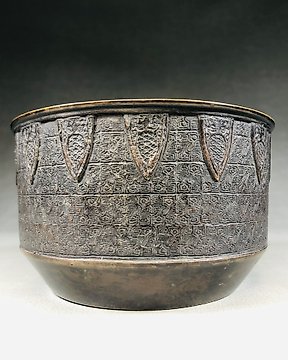
Seimin ju 整珉鋳 - Murata Seimin 村田整珉 Kensui 建水 - Vassoio - Contrassegnato con "Dai Nippon Bunsei nen Seimin ju" 大日本文政年整珉鋳 - Bronzo
N. 83252289

N. 83252289

It is a Kensui with the stamp of ``Dainippon Bunsei year Seitin casting'' made by Seitami Murata.
This Kensui is stamped with the ``Dainippon Bunsei Year Seimin Cast'' made by Murata Seimin.
Kensui 建水 - Bronze - Murata Seimin 村田整珉 (1761-1837) - With mark 'Dai Nippon Bunsei nen Seimin ju' 大日本文政年整珉鋳
Overall, there are no significant damages to the carvings, and the intricate details are clearly visible. While there are age-related stains, I believe the condition is very good for an Kensui from about 200 years ago.
A kensui is a utensil used in the Japanese tea ceremony to discard water or hot water used for rinsing or warming tea bowls. It is also called a "waste-water container." Materials used include pottery, porcelain, bamboo ware, copper, sand-clad ware, and in recent years, lightweight and durable materials such as acrylic are also used. The shape of a kensui typically features a wide opening for easy disposal of water, and it comes in various forms such as cylindrical, bucket-shaped, jar-shaped, and bowl-shaped.
Murata Seimin was born in Edo during the late Edo period and lived in Ryukamachi, Kanda. He was also known by the alias Sojiro and the pseudonym Seimin Kitatokusou. He left behind a variety of works, including ornaments, vases, suiban (shallow containers), and Buddhist altar fittings. Among his notable works are a pair of Tang lion statues at Shinjuku Hanazono Shrine, which were erected in the fourth year of Bunsei (1821), and a complete set of Buddhist altar fittings displayed at the National Museum. His fame skyrocketed when he was commissioned to create a stand for offering prayers at Nikko Toshogu Shrine's 200th-anniversary memorial during the twelfth year of Bunka (1815) by Shogun Ienari and the Kishu Domain Lord. His original surname was Kimura, but he became known as Murata after marrying into the Tamura family and combining both surnames. His disciples included Kimura Toun and Kurihara Teijou, among others. As a disciple of Tagawa Minetake, he established a successful family as a master caster, specializing in wax mold casting. After the passing of the first Seimin (born August 13, 1761, died November 24, 1837), his children were young, so Kimura Toun (originally from Iwate Prefecture), his adopted son and disciple, became the second Seimin. Later, the first Seimin's son (Senjiro) became the third Seimin.
Top 17.6 cm
Bottom 12.4 cm
Height 10.2 cm
Weight 830 g
Condition:
The condition is good for its age. Signs of wear from age, stains and scratches, oxidation. Please take a look at the numerous photos for more details.
Atention:
The items listed for sale are all used collectibles. Please consider them to have signs of aging, such as stains, scratches, scuffs, tears, discoloration, fading, fraying, and changes in thread color. We will post as many photos as possible to make it easy to understand. As these are old items, we appreciate your understanding before making a purchase.
Shipping:
The lot will be carefully packaged and shipped from Japan.
We will use either DHL or FedEx for a safe and secure transportation. It usually takes about 2-3 weeks for delivery, and the package will be shipped with a tracking number.
Import duties, taxes, VAT, and any other charges are not included in the item price and shipping cost. Please check your country's import duties before bidding.
031623130420
Come fare acquisti su Catawiki
1. Scopri oggetti speciali
2. Fai l’offerta più alta
3. Paga in tutta sicurezza